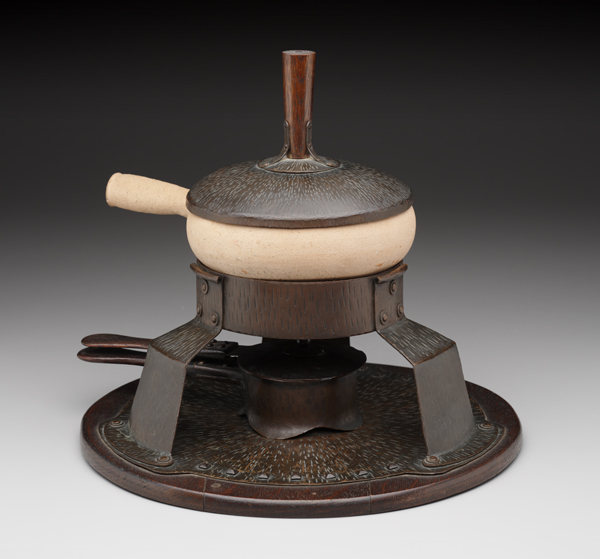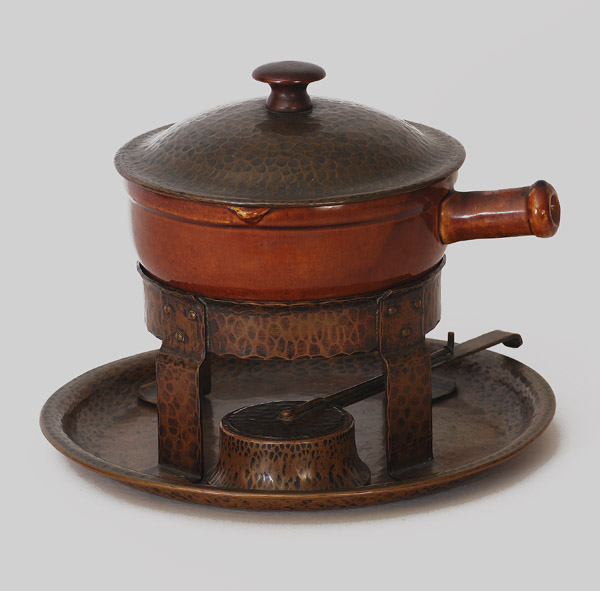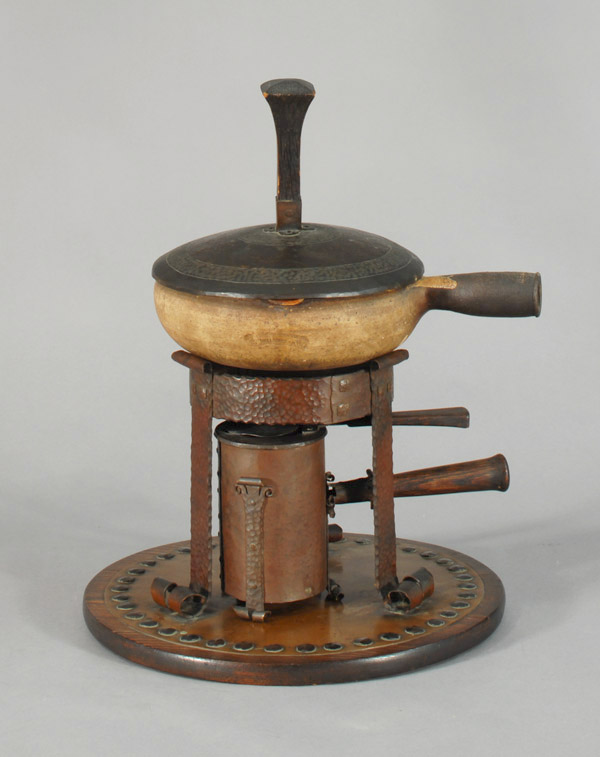Newsletter
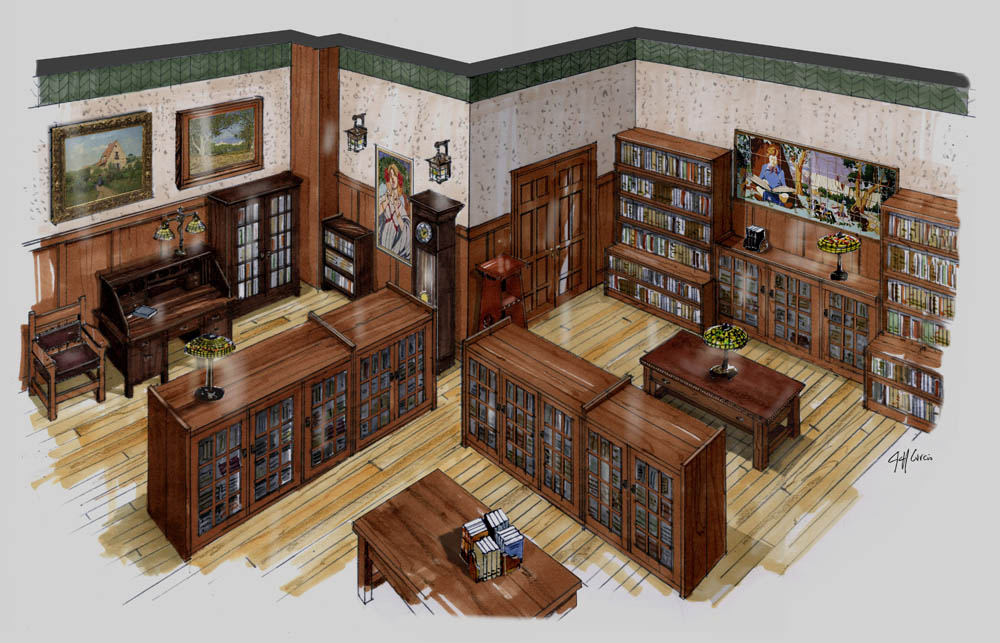
A key component of MAACM’s Mission Statement is its commitment to educate. That commitment is on full display in the museum’s planned library. Elegantly furnished with period objects, the room creates a striking visual presentation that can be seen through its large glass exterior walls. Gustav Stickley and L&JG Stickley bookcases, library tables, desks, and magazine stands, in addition to a colorful 90-foot wall border of Grueby tiles, stained glass windows, Tiffany lamps, and period oil paintings all come together to provide the viewer with a sense of timelessness and quiet decorum.
The museum's library, however, has goals far beyond the art objects it contains. TRRF's focused and growing collection of books, journals, periodicals, and auction catalogs will be housed here to serve as a user-friendly resource for students, scholars, and persons with an interest in the history of the Arts and Crafts Movement, mid-20th century decorative arts, printmaking, design, architecture and photography.
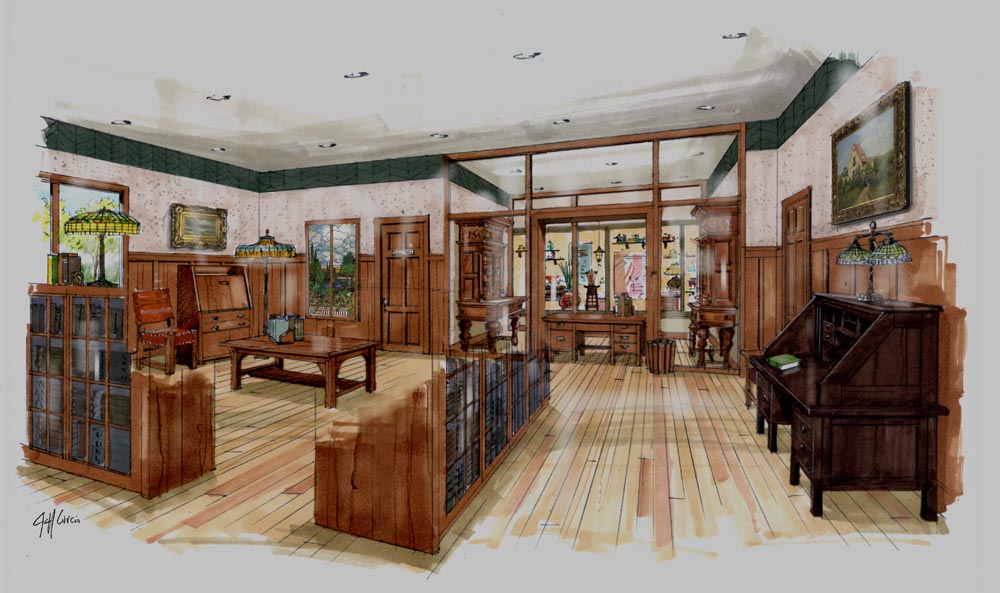
While not a traditional "lending library", a private "reading room" will be available with a reference librarian on hand to help visitors with requests, as well as computer stations with free Wi-Fi for research and study. The goal to build the library into a true resource and learning center is ambitious and not without its challenges. If you would like to donate books related to the TRRF collection, or are part of a specific wish-list we have developed, please contact us.
Perhaps the foremost expert on chafing dishes and related recipes is Janet McKenzie Hill (1852–1933), a prominent early practitioner of culinary reform, food science and scientific cooking and author of many cookbooks. Hill was born in Westfield, Massachusetts, the daughter of Alexander McKenzie, a clergyman, and Nancy (Lewis) McKenzie. In 1873 she married Benjamin M. Hill. Hill took up the study of cooking and its related sciences later in life: she returned to school around age 40, graduating from the Boston Cooking School in 1892. Fannie Farmer was assistant principal at the time. In 1896 she founded the Boston Cooking School Magazine (later renamed American Cookery). Hill produced several cookbooks promoting the products of a particular company, a practice that began during this period. Alice Bradley, an 1897 graduate of the Boston Cooking School, who later bought Miss Farmer's Cooking school and was cooking editor of the Woman's Home Companion for twenty years, got her start doing cooking demonstrations for Hill.
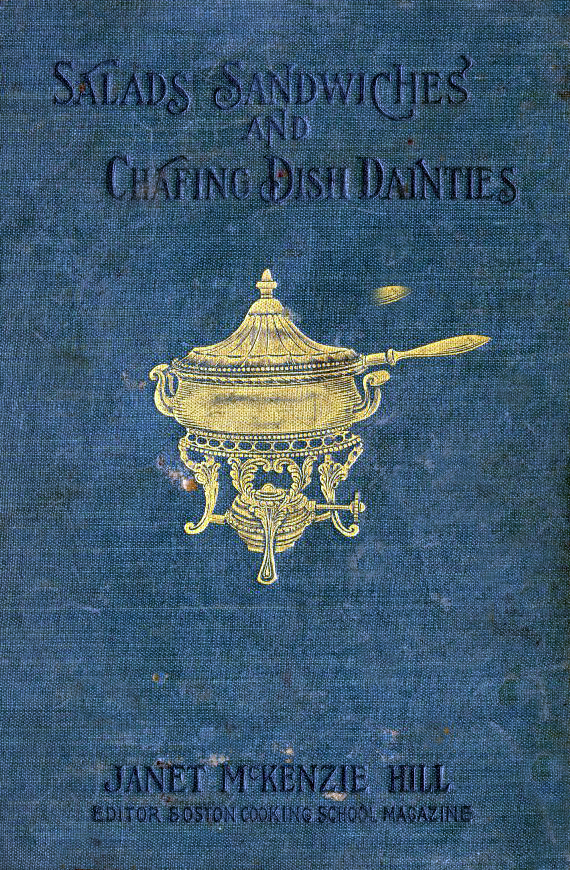
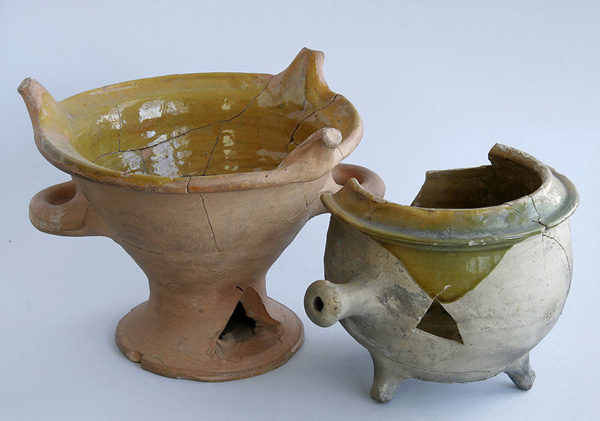
Two chafing dishes from 16th/17th century England.
In her famous cookbook Salads, Sandwiches and Chafing Dish Dainties, first published in 1899, Hill presented a brief history of the chafing dish as a cooking utensil and hundreds of chafing dish recipes. She explains:
“The chafing-dish is a portable utensil used upon the table, either for cooking food or for keeping food hot after it has been cooked by other means. In ancient times, the fuel of the chafing-dish was either live coals or olive oil; today we use either electricity, gas, alcohol or colonial spirits."
"The first chafing-dishes of which historic mention is made consisted of a pan heated over a pot of burning oil, the pan resting upon a frame which held the pot of oil. It was with such a utensil, perhaps, that the Israelitish women cooked the locusts of Egypt and Palestine, for these were eaten as a common food by the people of the biblical lands and age."
"Theodor Mommsen, in his History of Rome, while speaking of the extravagance of the times, as shown in the table furnishings, probably refers to the chafing-dish when he says: “A well-wrought bronze cooking-machine came to cost more than an estate.”
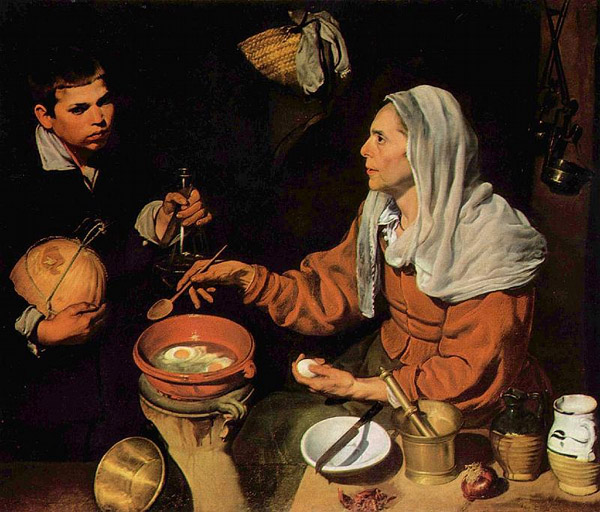
Diego Velazquez - Old Woman Frying Eggs - 1618
In the History of Chafing Dishes, author Adam Kelly writes:
"Beautifully crafted bronze chafing dishes were found in the ruins of Pompeii, showing they were in during the first century AD. They were highly prized by the Romans at their lavish banquets and later mentioned in historical letters dating to 1520, when the Spanish conquistador, Hernan Cortes, described to Charles V their profuse usage for keeping plates and dishes warm during sumptuous banquets for hundreds of gormandizing noblemen at the height of the Aztec empire.The 16th century baroque painter, Diego Velazquez, portrayed a woman preparing a meal of eggs in a chafing dish and Louis XV's kitchens used them to keep the dainty dishes for the epicurean courtiers piping hot. By the 17th century this form of cookware was being documented in household inventories in America. Velasquez's chafing dish appears to be earthenware, but silver chafing dishes used as plate-warmers were mentioned during the reign of Queen Anne, at the end of the 17th century”.
Julie Brown-Micko in her article for the Food Service News, Culinary Curiosities: The History of the Chafing Dish writes:
“Even Napoleon Bonaparte himself was pleased on occasion to cook a little omelet for himself and Empress Josephine in a chafing dish. The Waldorf-Astoria made use of them to serve delicacies to the financier J.P. Morgan. In the late 19th and early 20th century, the popularity of chafing dishes was at a near fever pitch. It was perhaps the combination of cozy intimacy with the flair of tableside cooking that made the chafing dish such a hit for home entertainment. It was billed as a great “civilizer,” encouraging families to entertain with style and care. Whether rich or poor, every householder was enjoined to have a chafing dish, and not just for parties”.
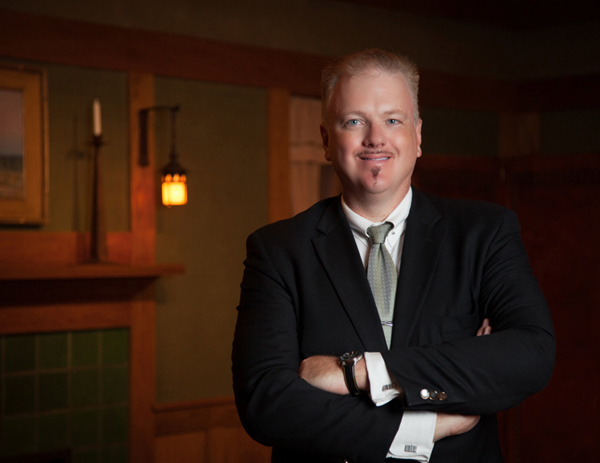
The Museum of the American Arts and Crafts Movement (MAACM) has announced that Kevin W. Tucker has been named the first director of the Museum, to be located in St. Petersburg, Florida. Tucker assumes his role with the MAACM on August 17, 2015.
"When considering this most important position, I couldn't think of a more qualified, capable and knowledgeable museum professional to lead this effort," said Rudy Ciccarello, the museum’s founder. "His understanding of the Arts and Crafts movement, the objects and the artists who created them, is exemplary and is based on his nearly 25 years of experience working in the field."
“I am honored to have been selected as the director of the Museum of the American Arts and Crafts Movement,” said Tucker. “I have long been fascinated by the early twentieth century and the contemporary resonance of its creative struggles to reconcile art, craft, industry, and rapid cultural change.”
Tucker previously served as The Margot B. Perot Senior Curator of Decorative Arts and Design at the Dallas Museum of Art (DMA), having joined that institution in 2003. During his tenure, he organized numerous exhibitions on the subject of early 20th-century design including Gustav Stickley and the American Arts & Crafts Movement (2010), Modernism in American Silver: 20th-Century Design (2005), and the recent Modern Opulence in Vienna: the Wittgenstein Vitrine (2014).
Tucker has served on the board of the Curators Committee (CURCOM) and has been involved with various regional and national professional committees, including that of the Association of Art Museum Curators (AAMC). He holds an MA degree in Applied History/Museum Studies and a BA in History from the University of South Carolina, and was the recipient of a 2007 Winterthur Research Fellowship for his work on Gustav Stickley and the American Arts & Crafts Movement.
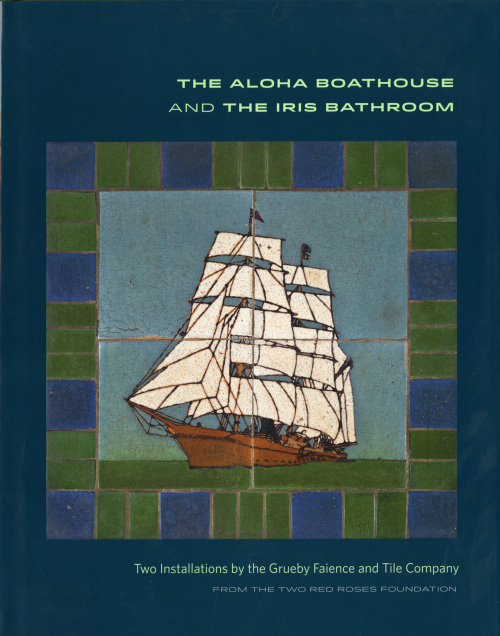
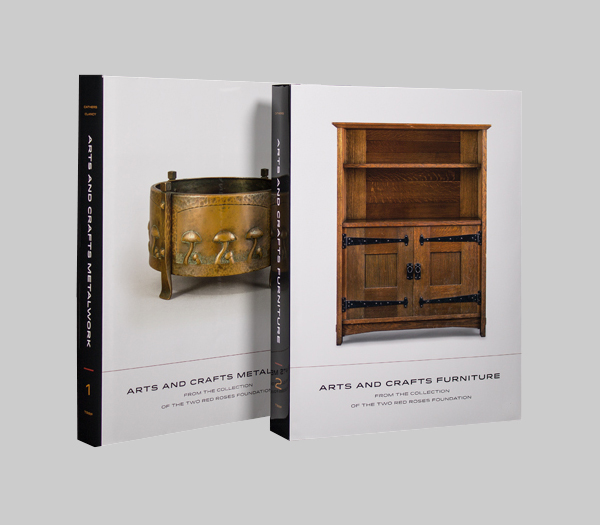
The TRRF has available for sale a group of books related to arts and crafts, architecture, design and photography. The foundation is not in the business of buying and selling books - we sell only the duplicates that accumulate in our library collection as donations are delivered. These books, as well as our six new collection catalogs we have published, are available on our website as well as ebay. Additionally, we also sell all our duplicate auction catalogs from Sotheby's, Christies, Rago Auctions, Toomey Galleries, Phillips, Skinner and others, but these catalogs are available only through ebay.
